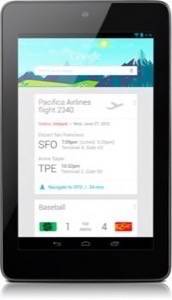
At first I was just stealing glances at my new Nexus 7, but now my relationship has escalated into full-on affair territory. Here’s why I left my upscale iPad for Google’s dirt-cheap tablet without really trying to make the switch at all.
1. Fits Like A Glove
The Nexus 7 doesn’t feel anything like an iPad – and that’s a good thing. The back of the 7-inch device is a lightly cushioned, dimpled rubber. it recalls the supple leather of driving gloves, according to Google lead designer Matias Duarte, and I couldn’t agree more.
Despite its curvaceous exterior, the iPad feels like a sharp slab of metal – a far cry from the worn paperback you might curl up with at the end of the day. The Nexus 7 is at once comfortable and familiar, with just enough grip around the edges. Between the eminently grippable back and the thick, scratch-averse glass of the display, I haven’t even considered buying a case for it.
While the iPad’s 10-inch screen might lend itself better to gaming and streaming entertainment, the Nexus 7’s dimensions are perfect for reading, emailing and surfing. The Kindle Fire has the same form factor, but beyond getting blown out of the water by the Nexus 7’s full version of Android, it exudes an impersonal coldness.

2. Android Customization
Android may still be building up a respectable software ecosystem, but at its essence, it’s perfect for the tablet form factor. Even without rooting, Google’s mobile OS offers an extreme level of customization thanks to launchers, widgets and deep tweaks like custom keyboards. With a little bit of elbow grease, you can sculpt Android to fit your own needs exactly.
Plenty of critics argue that iOS doesn’t require customization because it just works, but for many of us, tweaking the user interface is rewarding and easier than it sounds. With more screen real estate, customization opens up that much more opportunity for tailoring. Nearly all the iOS apps that I use regularly are available for Android in a near-identical version, and I can round out my device with all of the little Android-exclusive tweaks.
3. The Price Feels Right
Nexus 7 buyers are getting their money’s worth – and then some. The tablet costs $199, but it feels extremely well made, with a solid, thoughtful design. Still, the fact is that Google’s tablet will set you back less than half the price of a new iPad, and its affordability has a beneficial psychological effect, too.
My iPad lives full-time in a Smart Cover, and I wouldn’t be caught dead without a rubberized case to protect its aluminum back when I take it out on the town. The case and front cover add bulk that I don’t want, but at $499, it’s an expensive device, and I’d rather not risk damaging it.
The Nexus 7 feels cozy and comfortable but tough, too. I’m apt to toss it in a messenger bag and hop on my bike with no case at all, while my considerably more fragile iPad collects dust at home.
4. Widgets Are In Their Element
When rumors suggested that Apple would add an Android-like notification menu to iOS 5, some of us hoped for widgets, too. Whispers of a notification center panned out, but the iOS home screen is still a static experience of folders and apps.
I’ve been a fan of widgets on Android for some time. They’re the perfect at-a-glance means of visually representing important info like weather, Twitter @ replies or an inbox, but widgets come into their own on a tablet’s larger screen. Once you start adding and resizing widgets in Jelly Bean, it’s hard to imagine living without them.

5. Android’s Evolution
As a multi-platform owner of a small army of devices (including two Android smartphones, an iPhone and two iPads), Android feels better on a tablet. Jelly Bean rivals iOS in terms of polish, but it doesn’t sacrifice flexibility. The rigidity and simplicity of iOS makes for a great smartphone experience because we tend to use smartphones in short bursts. It accommodates quick actions texting with grace. But when we pick up a tablet, we’re settling in.
The Nexus 7 tablet experience deepens as you use the device, from Google Now’s smart learning to designing your home screen to accommodate how you work. Jelly Bean on the Nexus 7 is lightning fast and as smooth as the Project Butter initiative would suggest. I’ve been surprised to find myself using Google Voice Search, which has proven robust, fast and accurate, even for longer email dictations, while Siri is still too slow and fumbling for my needs on my iPhone 4S.
Ultimately, tablets – much like any gadget – aren’t a one-size-fits-all affair. I use my Nexus 7 for email, Google calendar, to do lists and casual web surfing, but the iPad’s larger, pixel-rich display (and well-stocked App Store) is more conducive to gaming and the like. Still, the Nexus 7 is a well-rounded device – and one with more than enough quad-core oomph to justify its modest price.
















